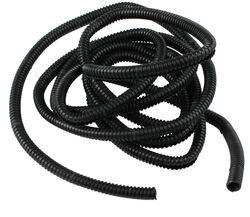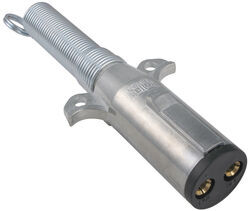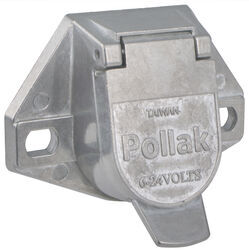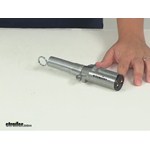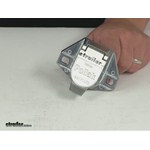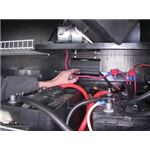
Parts Needed For Running A High Capacity Charge Line To Trailer
Question:
I understand the limitations of the 12V chargefoot line thru the 7way plug and want to significantly improve on that. Im installing a lithium battery maybe 2 in the trailer along with an MPPT charge controller that will take a feed from the vehicle. I understand I need to run a 6 gauge wire from the the front of the vehicle back to the trailer with a high capacity plug and jack like the Pollak 1 or 2 pole units as I expect to be pushing over 25 amps. Here are my questions. 1 Do I need to run a separate ground negative connection thru between the vehicle and the trailer? Or is the physical contact with the hitch sufficient? Im concerned that will not be reliable for this. If separate connection I would use the 2 pole connectors and run short lead to chassis ground on both sides I presume. 2 Do you recommend welding cable or battery cable for these runs? Not sure what the real difference is between them. Or something else? Thanks.
asked by: Mark C
Expert Reply:
Yes, you will need to run a separate ground wire with the main power wire. So it would be best to use the Pollak 2-Pole Socket Connector # PK12801 with their 2-Pole Trailer Wiring Connector # PK12800 for your power wires. The physical connection from the ball mount will not work as an acceptable ground connection.
I recommend using battery cable as a suitable cable for the power wires. If you need help determining the correct gauge for your length let me know how far the cable will be ran be sure to include any changes in direction to your meausrement. Be sure that you use Wire Loom # 7509-10 to protect the wiring from chaffing and any heat shielding if you run near the exhaust or engine components.
This will allow you to use a MPPT type charger like the Redarc In-Vehicle BCDC Battery Charger # 331-BCDC1225D.

Products Referenced in This Question
Redarc In-Vehicle BCDC Battery Charger - Dual Input - DC to DC - 12V/24V - 25 Amp
- Battery Charger
- Battery Charger
- RV/Camper
- Trailer
- 75 Ah
- 200 Ah
- Charges/Maintains
- 12V
- Solar Panels to Auxiliary Battery
- Vehicle Battery to Auxiliary Battery
- Redarc
more information >
Wire Loom 1/4" Diameter, 10' Long
- Wiring
- Wiring Protection
- Wire Loom
- 1/4 Inch Diameter
- Spectro
more information >
2-Pole Trailer Wiring Connector - Trailer Side
- Trailer Wiring
- Trailer Connectors
- Trailer End Connector
- Plug Only
- 2 Pole
- Pollak
more information >
Product Page this Question was Asked From
2-Pole Socket Connector - Vehicle Side
- Trailer Wiring
- Trailer Connectors
- Vehicle End Connector
- Plug Only
- 2 Pole
- Pollak
more information >
Featured Help Information
Instructions
Miscellaneous Media

Continue Researching
- Shop: Trailer Wiring
- Video: Buyers Products Wiring - Trailer Connectors - 337TC1002 Review
- Video: Pollak Wiring - Trailer Connectors - PK12801 Review
- Video: Curt Custom Fit Vehicle Wiring - Trailer Hitch Wiring - C55242 Review
- Shop: 2-Pole Socket Connector - Vehicle Side
- Shop: Buyers Products 2-Way Die-Cast Zinc Trailer Connector - Truck Side - Horizontal Pin Arrangement
- Shop: Ford Replacement OEM Tow Package Wiring Harness, 7-Way
- Shop: Curt T-Connector Vehicle Wiring Harness for Factory Tow Package - 7-Way Trailer Connector
- Shop: 7- and 4-Pole Trailer Connector Socket w/ Mounting Bracket - Vehicle End
- Q&A: Location of Fuses for Curt T-Connector Vehicle Wiring Harness on 2003 Ford F-150
- Q&A: Installing a 7-Way Trailer Connector on a 2001 Ford F-150
- Q&A: Can Wiring be Soldered to the Back of the Pollack 2-Pole Vehicle Side Trailer Connector
- Q&A: 1998 Ford F150 4 Pin To 7 Pin Connector Upgrade
- Q&A: What is the Difference Between the Pollak and Buyers Products 2-Pole Socket Connectors
- Q&A: Does the 2-Pole Trailer Wiring Connector # PK12800 Solder or Use Terminals
- Q&A: How Many Amps Can the Buyers Products 337TC1002 Accommodate
- Shop: 2-Pole Trailer Wiring Connector - Trailer Side
- Shop: Pollak Single-Pole, Round Pin Trailer Wiring Socket - Vehicle End
- Video: Pollak Wiring - Trailer Connectors - PK11851 Review
- Video: Pollak Wiring - Trailer Connectors - PK12800 Review
- Search Results: 2 pole
- Search Results: 2 pole plug
- Video: Review of Buyers Products - Trailer Fenders - 337B52169
- Video: Pollak Wiring PK11763 Review





